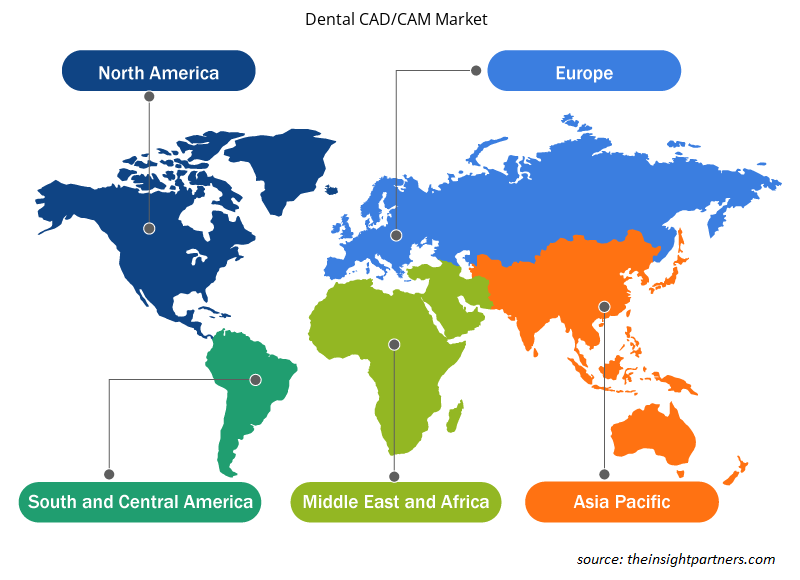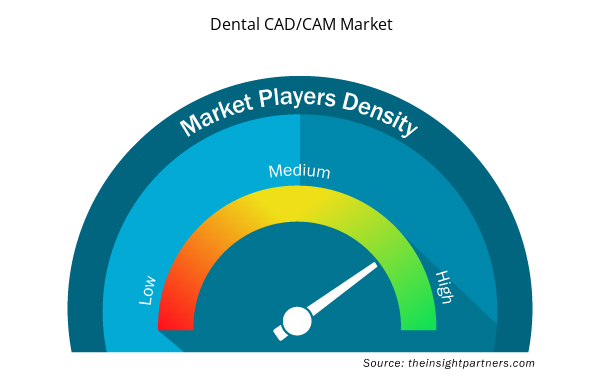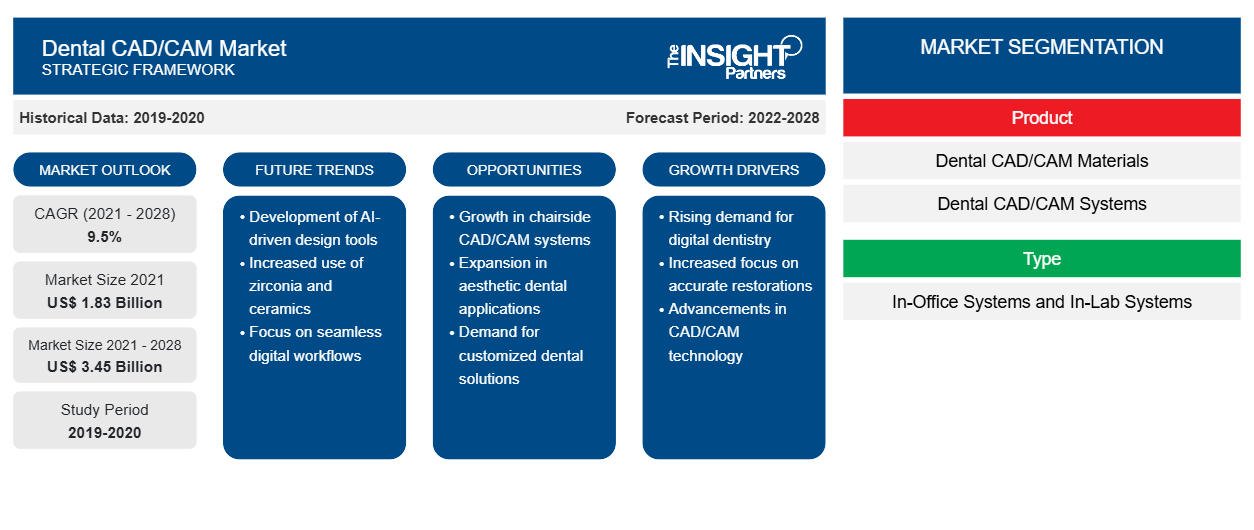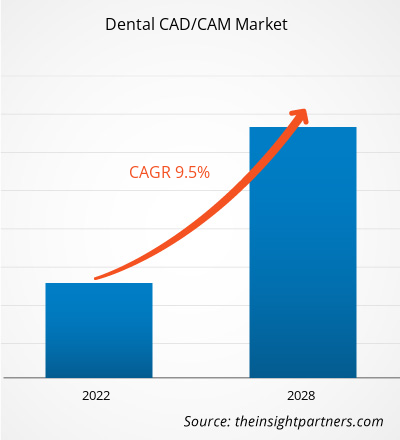Der Markt für dentale CAD/CAM-Systeme soll von 1.829,77 Millionen US-Dollar im Jahr 2021 auf 3.447,12 Millionen US-Dollar im Jahr 2028 wachsen; von 2021 bis 2028 wird mit einer durchschnittlichen jährlichen Wachstumsrate von 9,5 % gerechnet. CAGR of 9.5% from 2021 to 2028.
Dental Computer-Aided Design and Computer-Aided Manufacturing oder CAD-CAM ist die Automatisierungstechnologie, die bei der Zahnrestauration hilft. CAD/CAM ergänzt frühere Technologien, die für diese Dentallösungen verwendet wurden, indem es die Geschwindigkeit von Design und Herstellung erhöht und die Eignung und Einfachheit der Erfindungs-, Konstruktions- und Platzierungsprozesse verbessert. Diese Technologie hat Restaurationen ermöglicht, die sonst nicht möglich gewesen wären. Weitere Ziele sind die Senkung der Stückkosten und die Erschwinglichkeit von Zahnreparaturen. Der Anstieg der Zahnverlustrate, das Wachstum der zahnlosen Bevölkerung, die Vorteile dentaler CAD/CAM-basierter Restaurationen gegenüber dentalen Laborrestaurationen, technologische Fortschritte bei dentalen CAD/CAM-Systemen, das Wachstum bei Dentalserviceorganisationen und die steigende Nachfrage nach fortschrittlichen Dentallösungen werden voraussichtlich das Wachstum des dentalen CAD/CAM-Marktes vorantreiben .
Passen Sie diesen Bericht Ihren Anforderungen an
Sie erhalten kostenlos individuelle Anpassungen an jedem Bericht, einschließlich Teilen dieses Berichts oder einer Analyse auf Länderebene, eines Excel-Datenpakets sowie tolle Angebote und Rabatte für Start-ups und Universitäten.
- Holen Sie sich die wichtigsten Markttrends aus diesem Bericht.Dieses KOSTENLOSE Beispiel umfasst eine Datenanalyse von Markttrends bis hin zu Schätzungen und Prognosen.
Der Dental-CAD/CAM-Markt ist nach Produkt, Typ, Komponenten, Anwendung, Endbenutzer und Geografie segmentiert. Geografisch ist der Dental-CAD/CAM-Markt grob in Nordamerika, Europa, Asien-Pazifik, den Nahen Osten und Afrika sowie Süd- und Mittelamerika unterteilt. Der Bericht bietet Einblicke und eine eingehende Analyse des Dental-CAD/CAM-Marktes und betont Parameter wie Markttrends, technologische Fortschritte, Marktdynamik und die Analyse der Wettbewerbslandschaft der weltweit führenden Marktteilnehmer.
Markteinblicke:
Zunehmende orale Erkrankungen und geriatrische Bevölkerung treiben das Wachstum des Dental-CAD/CAM-Marktes voran
Die steigende Zahl von Zahnerkrankungen ist einer der Hauptfaktoren, die zum Wachstum der Dentalbranche beitragen. Laut dem National Center for Health Statistics (USA) hatten im April 2021 in Nordamerika ~13,2 % der Kinder (5–19 Jahre) und ~25,9 % der Erwachsenen (20–44 Jahre) unbehandelte Karies. Darüber hinaus berichtete das National Center for Health Statistics, dass 64,9 % der US-Erwachsenen ab 19 Jahren und 85,9 % der Kinder im Alter von 2–17 Jahren im Jahr 2019 mindestens einmal den Zahnarzt besuchten; im März 2020 litten ~3,5 Milliarden Menschen an Zahnerkrankungen wie unbehandelter Karies. Darüber hinaus stellte die WHO fest, dass Mundhöhlenkrebs in den Ländern im asiatisch-pazifischen Raum zu den drei am häufigsten festgestellten Krebsarten gehört. Laut der Weltbevölkerungsstatistik der Vereinten Nationen waren 2019 weltweit etwa 703 Millionen Menschen 65 Jahre oder älter, und diese Zahl wird sich bis 2050 voraussichtlich auf 1,5 Milliarden verdoppeln. Die Mundgesundheit ist aufgrund biologischer, verhaltensbedingter und sozioökonomischer Faktoren direkt mit dem Altern verbunden, was zu einer Verschlechterung der Mundgesundheit bei der geriatrischen Bevölkerung führt. Da die Zahl der geriatrischen Bevölkerung weltweit zunimmt, wird die Nachfrage nach zahnärztlichen Behandlungen steigen und das Wachstum des Dental-CAD/CAM-Marktes vorantreiben.
Steigende Verbreitung von Chairside-CAD/CAM-Systemen trägt erheblich zum Marktwachstum bei
In der Zahnmedizin haben sich Technologien für computergestütztes Design und Fertigung (CAD/CAM) rasant ausgebreitet. Die Produktvorbereitung wird mit der Chairside-Technik gescannt und die Restauration wird dann im Fräsgerät (CEREC 3, Sirona, E4D, D4D TECH) hergestellt. Chairside-CAD/CAM-Systeme sind seit mehreren Jahren auf dem Markt im Trend, da die Restaurationsgestaltung mit diesen Systemen nachweislich effektiv und präzise ist. Zahnärzte nutzen CAD/CAM-Systeme für Zahnarztstühle, um Zeit zu sparen, die Zahl der Patientenbesuche zu erhöhen und ihr Einkommen zu verbessern. Mit diesen Systemen können Zahnärzte den gesamten Prozess steuern, angefangen beim digitalen Abdruck der präparierten Zähne bis hin zum Design und der Herstellung der Zahnrestaurationen. Diese Systeme bieten einzigartige Vorteile wie besseren Patientenkomfort, kürzere Behandlungszeiten und verbesserte Qualität. Sie verschaffen Zahnärzten auch einen Wettbewerbsvorteil, indem sie ihnen helfen, digitale Dienste schneller bereitzustellen. Daher setzen viele Zahnärzte auf Chairside-CAD/CAM-Systeme und treiben so das Wachstum des Dental-CAD/CAM-Marktes voran.chairside technique, and the restoration is then fabricated in the milling device (CEREC 3, Sirona, E4D, D4D TECH). Chairside CAD/CAM systems have been trending in the market for several years due to the proven effectiveness and accuracy of restoration design using these systems. Dentists consider dental chair CAD/CAM systems to save time, increase patient visits, and improve income. These systems allow dentists to control the entire process, starting with the digital impression of prepared teeth to design and fabrication of the dental restorations. These systems offer unique advantages, such as better patient comfort, shorter procedure times, and improved quality. They also provide dentists a competitive edge by helping them deliver digital services faster. Therefore, many dentists are adopting chair-side CAD/CAM systems, thus driving the dental CAD/CAM market growth.
Produkteinführungen sowie Fusionen und Übernahmen sind die am häufigsten eingesetzten Strategien der Akteure auf dem globalen Dental-CAD/CAM-Markt. Nachfolgend sind einige der jüngsten wichtigen Produktentwicklungen aufgeführt:
- Im Mai 2021 kündigte CIMsystem die Einführung eines neuen Produkts namens MillBox an. Dieses neue Produkt verfügt über eine speziell für den sofortigen Einsatz entwickelte Benutzeroberfläche mit spannenden neuen Funktionen, die es Zahnärzten ermöglichen, schneller zu arbeiten.
- Im Dezember 2021 gab die Envista Holdings Corporation die Zulassung der US-amerikanischen Food and Drug Administration (FDA) für das Implantatsystem Nobel Biocare N1 bekannt. Die neue Produktzulassung zeichnet sich durch ein biologisch orientiertes Design der Komponenten und zukunftsweisende Behandlungsprotokolle aus und stellt einen bedeutenden Schritt in Richtung patientenzentrierter Implantatlösungen dar.
- Im Juni 2020 kündigten Zimmer Biomet und Zfx (bieten hochwertige CAD/CAM-Restaurationskomponenten für die beliebteste Zahnimplantatverbindung der Branche) die Einführung von GenTek an, einer neuen digitalen Restaurationsproduktlinie für das Zahnimplantatsystem von Zimmer Biomet. Das neu eingeführte Produkt bietet restaurative Lösungen basierend auf den Bedürfnissen der Patienten, indem es die Integrität des klinisch erprobten Implantatverbindungsdesigns stärkt.
Die COVID-19-Pandemie hatte aufgrund der Schließung von Praxen erhebliche Auswirkungen auf die zahnmedizinische Diagnostik in mehreren Regionen. Die COVID-19-Pandemie veränderte die klinischen und chirurgischen Routinen radikal und hatte tiefgreifende Auswirkungen auf viele Gesundheits- und chirurgische Praxen, wie z. B. begrenztes Personal, Priorisierung von Verfahren und intraoperative Übertragung. Laut dem Bericht der Agency for Healthcare Research and Quality zwang der Ausbruch der COVID-19-Pandemie im Jahr 2019 etwa 198.000 aktive Zahnärzte und Zahnspezialisten dazu, ihre Praxen in den USA zu schließen. Darüber hinaus kam es während der COVID-19-Pandemie zu Verzögerungen bei der zahnärztlichen Versorgung von Patienten aufgrund der strengen Schließung von Zahnarztpraxen, der Zurückhaltung, während der Pandemie eine Behandlung in Anspruch zu nehmen, des Verlusts des arbeitgeberfinanzierten Zahnversicherungsschutzes und anderer Faktoren. Vor der Pandemie gewann die zahnärztliche CAD/CAM-Technologie stark an Bedeutung, da routinemäßige Zahnarztbesuche lukrative Möglichkeiten bieten, indem sie eine vorbeugende Mundgesundheitspflege bieten und orale Manifestationen systemischer Erkrankungen erkennen, die während der COVID-19-Pandemie enorm übersehen wurden.
Die COVID-19-Pandemie hat auch den Markt für dentalen 3D-Druck beeinflusst. Nach der anfänglichen Verlangsamung steigen die Verkäufe von 3D-Druckern jedoch wieder schnell an. Darüber hinaus bieten digitale Technologien wie 3D-Drucker und Intraoralscanner eine bessere Kontrolle des Kontaminationsrisikos, was bereits zu steigenden Verkäufen geführt hat. Da technologische Verbesserungen für mehr Zuverlässigkeit sorgen, wird die Nachfrage nach digitaler Technologie in der Zahnmedizin wahrscheinlich höher sein. Darüber hinaus bieten digitale Technologien eine bessere Sicherheit und Infektionskontrolle, was ihre Verbreitung in Zukunft voraussichtlich vorantreiben wird.
Regionale Einblicke in den Dental-CAD/CAM-Markt
Die regionalen Trends und Faktoren, die den Dental-CAD/CAM-Markt während des Prognosezeitraums beeinflussen, wurden von den Analysten von Insight Partners ausführlich erläutert. In diesem Abschnitt werden auch Dental-CAD/CAM-Marktsegmente und -Geografie in Nordamerika, Europa, im asiatisch-pazifischen Raum, im Nahen Osten und Afrika sowie in Süd- und Mittelamerika erörtert.

- Erhalten Sie regionale Daten zum Dental-CAD/CAM-Markt
Umfang des Dental-CAD/CAM-Marktberichts
| Berichtsattribut | Details |
|---|---|
| Marktgröße im Jahr 2021 | 1,83 Milliarden US-Dollar |
| Marktgröße bis 2028 | 3,45 Milliarden US-Dollar |
| Globale CAGR (2021 - 2028)CAGR (2021 - 2028) | 9,5 % |
| Historische Daten | 2019-2020 |
| Prognosezeitraum | 2022–2028 |
| Abgedeckte Segmente | Nach Produkt
|
| Abgedeckte Regionen und Länder | Nordamerika
|
| Marktführer und wichtige Unternehmensprofile |
|
Dichte der Akteure auf dem Dental-CAD/CAM-Markt: Die Auswirkungen auf die Geschäftsdynamik verstehen
Der Dental-CAD/CAM-Markt wächst rasant, angetrieben durch die steigende Nachfrage der Endnutzer aufgrund von Faktoren wie sich entwickelnden Verbraucherpräferenzen, technologischen Fortschritten und einem größeren Bewusstsein für die Vorteile des Produkts. Mit der steigenden Nachfrage erweitern Unternehmen ihr Angebot, entwickeln Innovationen, um die Bedürfnisse der Verbraucher zu erfüllen, und nutzen neue Trends, was das Marktwachstum weiter ankurbelt.
Die Marktteilnehmerdichte bezieht sich auf die Verteilung der Firmen oder Unternehmen, die in einem bestimmten Markt oder einer bestimmten Branche tätig sind. Sie gibt an, wie viele Wettbewerber (Marktteilnehmer) in einem bestimmten Marktraum im Verhältnis zu seiner Größe oder seinem gesamten Marktwert präsent sind.
Die wichtigsten auf dem Dental-CAD/CAM-Markt tätigen Unternehmen sind:
- Dentsply Sirona
- PLANMECA OY
- 3Form
- Zimmer Biomet
- Dentallabor.
Haftungsausschluss : Die oben aufgeführten Unternehmen sind nicht in einer bestimmten Reihenfolge aufgeführt.

- Überblick über die wichtigsten Akteure auf dem Dental-CAD/CAM-Markt
Dental CAD/CAM – Marktsegmentierung
Der Dental-CAD/CAM-Markt ist nach Produkt, Typ, Komponenten, Anwendung und Endbenutzer segmentiert. Basierend auf dem Produkt ist der Dental-CAD/CAM-Markt weiter unterteilt in Dental-CAD/CAM-Materialien und Dental-CAD/CAM-Systeme. Basierend auf dem Typ ist der Markt weiter unterteilt in In-Office-Systeme und In-Labor-Systeme. Basierend auf den Komponenten ist der Dental-CAD/CAM-Markt weiter unterteilt in Hardware und Software. Basierend auf der Anwendung ist der Dental-CAD/CAM-Markt weiter unterteilt in Zahnprothesen, Zahnimplantate und Sonstiges. Basierend auf dem Endbenutzer ist der Dental-CAD/CAM-Markt weiter unterteilt in Zahnkliniken, Dentallabore, Fräszentren und Sonstiges. Geografisch ist der globale Dental-CAD/CAM-Markt segmentiert in Nordamerika (USA, Kanada und Mexiko), Europa (Frankreich, Deutschland, Großbritannien, Spanien, Italien und der Rest von Europa), Asien-Pazifik (China, Indien, Japan, Australien, Südkorea und der Rest von Asien-Pazifik), den Nahen Osten und Afrika (Saudi-Arabien, Vereinigte Arabische Emirate, Südafrika und der Rest von Afrika) sowie Süd- und Mittelamerika (Brasilien, Argentinien und der Rest von Südamerika).
Firmenprofile
- Dentsply Sirona
- PLANMECA oy
- 3Form
- Zimmer Biomet
- Dentallabor.
- ENVISTA HOLDING CORPORATION
- 3M
- Kelkar Dynamics LLP
- Ivoclar Vivadent AG
- DATRON AG
- Align Technology, Inc.
- Institut Strauman AG
- Amann Girrbach AG
- Roland DGA Corporation
- CIM-System
- Historische Analyse (2 Jahre), Basisjahr, Prognose (7 Jahre) mit CAGR
- PEST- und SWOT-Analyse
- Marktgröße Wert/Volumen – Global, Regional, Land
- Branche und Wettbewerbsumfeld
- Excel-Datensatz



Report Coverage
Revenue forecast, Company Analysis, Industry landscape, Growth factors, and Trends

Segment Covered
This text is related
to segments covered.

Regional Scope
North America, Europe, Asia Pacific, Middle East & Africa, South & Central America

Country Scope
This text is related
to country scope.
Häufig gestellte Fragen
Global dental CAD/CAM market is segmented by region into North America, Europe, Asia Pacific, Middle East & Africa, and South & Central America. In North America, the U.S. is the largest market for dental CAD/CAM market. The US is estimated to hold the largest share in the dental CAD/CAM market during the forecast period. Increasing adoption of technological advancements and rising research and development activities are projected to accelerate the growth of the dental CAD/CAM market. Moreover, the presence of large healthcare businesses and the growing usage of Dental CAD/CAM is propelling the market's expansion in this region. Increasing trend of prosthetics particularly in Thailand and Malaysia. Additionally, advancing healthcare infrastructure is the contributing factor for the dental CAD/CAM growth in APAC region is the key factor responsible for the Asia-Pacific regional growth for dental CAD/CAM accounting fastest growth of the region during the coming years.
The dental clinics segment dominated the global dental CAD/CAM market and accounted for the largest market share of 37.48% in 2021.
Dentsply Sirona; PLANMECA OY; 3Shape; Zimmer Biomet; Carestream Dental LLC.; ENVISTA HOLDING CORPORATION; 3M; Kelkar Dynamics LLP; Ivoclar Vivadent AG; Datron AG; Align Technology, Inc.; Institut Straumann AG; Amann Girrbach AG; Roland DGA Corporation; and CIMsystem are among the leading companies operating in the global dental CAD/CAM market.
Dental CAD/CAM is defined as technological aids that makes it possible for dental professionals to perform complex restorations faster, efficiently, and sometimes more accurately. Both dental and laboratories utilize CAD/CAM technology for constructing restorations such as crowns, inlays, onlays, veeners, bridges, and implant-supported restorations from high-strength ceramics.
Increasing oral diseases and geriatric population and rising adoption of chair-side CAD/CAM systems are the most significant factors responsible for the overall market growth.
Based on components, hardware segment took the forefront lead in the worldwide market by accounting largest share in 2020 and is expected to continue to do so till the forecast period.
Trends and growth analysis reports related to Technology, Media and Telecommunications : READ MORE..
The List of Companies - Dental CAD/CAM Market
- Dentsply Sirona
- PLANMECA OY
- 3Shape
- Zimmer Biomet
- Carestream Dental LLC.
- ENVISTA HOLDING CORPORATION
- 3M
- Kelkar Dynamics LLP
- Ivoclar Vivadent AG
- Datron AG
- Align Technology, Inc.
- Institut Straumann AG
- Amann Girrbach AG
- Roland DGA Corporation
- CIMsystem
The Insight Partners performs research in 4 major stages: Data Collection & Secondary Research, Primary Research, Data Analysis and Data Triangulation & Final Review.
- Data Collection and Secondary Research:
As a market research and consulting firm operating from a decade, we have published and advised several client across the globe. First step for any study will start with an assessment of currently available data and insights from existing reports. Further, historical and current market information is collected from Investor Presentations, Annual Reports, SEC Filings, etc., and other information related to company’s performance and market positioning are gathered from Paid Databases (Factiva, Hoovers, and Reuters) and various other publications available in public domain.
Several associations trade associates, technical forums, institutes, societies and organization are accessed to gain technical as well as market related insights through their publications such as research papers, blogs and press releases related to the studies are referred to get cues about the market. Further, white papers, journals, magazines, and other news articles published in last 3 years are scrutinized and analyzed to understand the current market trends.
- Primary Research:
The primarily interview analysis comprise of data obtained from industry participants interview and answers to survey questions gathered by in-house primary team.
For primary research, interviews are conducted with industry experts/CEOs/Marketing Managers/VPs/Subject Matter Experts from both demand and supply side to get a 360-degree view of the market. The primary team conducts several interviews based on the complexity of the markets to understand the various market trends and dynamics which makes research more credible and precise.
A typical research interview fulfils the following functions:
- Provides first-hand information on the market size, market trends, growth trends, competitive landscape, and outlook
- Validates and strengthens in-house secondary research findings
- Develops the analysis team’s expertise and market understanding
Primary research involves email interactions and telephone interviews for each market, category, segment, and sub-segment across geographies. The participants who typically take part in such a process include, but are not limited to:
- Industry participants: VPs, business development managers, market intelligence managers and national sales managers
- Outside experts: Valuation experts, research analysts and key opinion leaders specializing in the electronics and semiconductor industry.
Below is the breakup of our primary respondents by company, designation, and region:

Once we receive the confirmation from primary research sources or primary respondents, we finalize the base year market estimation and forecast the data as per the macroeconomic and microeconomic factors assessed during data collection.
- Data Analysis:
Once data is validated through both secondary as well as primary respondents, we finalize the market estimations by hypothesis formulation and factor analysis at regional and country level.
- Macro-Economic Factor Analysis:
We analyse macroeconomic indicators such the gross domestic product (GDP), increase in the demand for goods and services across industries, technological advancement, regional economic growth, governmental policies, the influence of COVID-19, PEST analysis, and other aspects. This analysis aids in setting benchmarks for various nations/regions and approximating market splits. Additionally, the general trend of the aforementioned components aid in determining the market's development possibilities.
- Country Level Data:
Various factors that are especially aligned to the country are taken into account to determine the market size for a certain area and country, including the presence of vendors, such as headquarters and offices, the country's GDP, demand patterns, and industry growth. To comprehend the market dynamics for the nation, a number of growth variables, inhibitors, application areas, and current market trends are researched. The aforementioned elements aid in determining the country's overall market's growth potential.
- Company Profile:
The “Table of Contents” is formulated by listing and analyzing more than 25 - 30 companies operating in the market ecosystem across geographies. However, we profile only 10 companies as a standard practice in our syndicate reports. These 10 companies comprise leading, emerging, and regional players. Nonetheless, our analysis is not restricted to the 10 listed companies, we also analyze other companies present in the market to develop a holistic view and understand the prevailing trends. The “Company Profiles” section in the report covers key facts, business description, products & services, financial information, SWOT analysis, and key developments. The financial information presented is extracted from the annual reports and official documents of the publicly listed companies. Upon collecting the information for the sections of respective companies, we verify them via various primary sources and then compile the data in respective company profiles. The company level information helps us in deriving the base number as well as in forecasting the market size.
- Developing Base Number:
Aggregation of sales statistics (2020-2022) and macro-economic factor, and other secondary and primary research insights are utilized to arrive at base number and related market shares for 2022. The data gaps are identified in this step and relevant market data is analyzed, collected from paid primary interviews or databases. On finalizing the base year market size, forecasts are developed on the basis of macro-economic, industry and market growth factors and company level analysis.
- Data Triangulation and Final Review:
The market findings and base year market size calculations are validated from supply as well as demand side. Demand side validations are based on macro-economic factor analysis and benchmarks for respective regions and countries. In case of supply side validations, revenues of major companies are estimated (in case not available) based on industry benchmark, approximate number of employees, product portfolio, and primary interviews revenues are gathered. Further revenue from target product/service segment is assessed to avoid overshooting of market statistics. In case of heavy deviations between supply and demand side values, all thes steps are repeated to achieve synchronization.
We follow an iterative model, wherein we share our research findings with Subject Matter Experts (SME’s) and Key Opinion Leaders (KOLs) until consensus view of the market is not formulated – this model negates any drastic deviation in the opinions of experts. Only validated and universally acceptable research findings are quoted in our reports.
We have important check points that we use to validate our research findings – which we call – data triangulation, where we validate the information, we generate from secondary sources with primary interviews and then we re-validate with our internal data bases and Subject matter experts. This comprehensive model enables us to deliver high quality, reliable data in shortest possible time.


 Holen Sie sich ein kostenloses Muster für diesen Bericht
Holen Sie sich ein kostenloses Muster für diesen Bericht